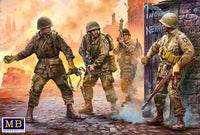The first attempts to use airborne units took place in the US armed forces in the early 1930s, but they turned out to be unsuccessful. Only the outbreak of World War II in Europe accelerated the development of this formation in the United States, and the first parachute unit in the history of the US Army was one of the platoons of the 29th Infantry Regiment, which in 1940 underwent appropriate training. One of the most important figures in the development of American airborne units was General William C. Lee, also known as the father of this formation. During World War II, two airborne divisions were formed: the 82nd ("All American") and the 101st ("Screaming Eagle"). American troops of this type played a huge role in the first days of the operation in Normandy (June 1944), but also fought later as part of Operation Market-Garden (1944) or Varsity (1945).
101st Airborne Division is an American tactical union bearing the unofficial name of Screaming Eagles. The unit was formed in August 1942 and, together with the 82nd Airborne Division, was the backbone of this type of troops during World War II. From the very beginning, it was also formed according to the positions provided for parachute troops. The first commander of the unit was General William C. Lee, but shortly before the division's entry into action, he suffered a heart attack, which meant that its commander throughout World War II was General Maxwell Taylor, an officer who had already served as a paratrooper in the course of operations. in Sicily in 1943. The 101st Airborne Division received its baptism of fire during Operation Overlord and shortly afterwards took part in Operation Market-Garden. However, the achievements of the division in the defense of the city of Bastogne in December 1944 during the German counter-offensive in the Ardennes, when despite the shortages in weapons, ammunition, and winter equipment and with part-time personnel, the division managed to stay in the city and wait for the relief of the American 3, went down in history. An army led by General Patton. It is worth adding that in 1945 the division entered Germany, but it did not take part in any active fights. After 1945, the division took part in combat operations, including in the Vietnam War (1964/1965-1975) or during the First Gulf War (1990–1991). The 101st Airborne Division is considered one of the most famous tactical units of the American armed forces.














